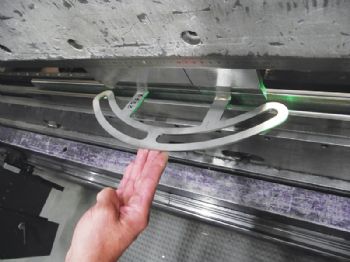
Spooner Industries has been a leading innovator in ‘air movement and heat transfer technology’ since 1932.
Operating with 150 employees at 40,000ft
2 premises in Ilkley, the company produces custom-designed industrial process machinery such as tunnel ovens, air flotation dryers and coolers for a variety of market sectors — including food and paper.
Vero Software’s sheet-metal CAD/CAM solution Radan (
www.radan.com) is used to program Spooner’s Trumpf laser cutter and two Bystronic press brakes; and while most parts have an average of four folds, which need to be programmed in the correct bending squence, some of the more complex components need up to 15 folds.
Spooner production engineer Nick Murgatroyd says that around 21 separate steps were previously required to import each individual Autodesk Inventor part file into Radan’s press brake module, Radbend.
“Then we had to open it in Radbend and program the bending sequence, save it, and open the new file for whichever one of our two Bystronic Xpert 250 press brakes we were using for the job. Two people were assigned to the task full-time.”
Now, using a macro developed by Radan engineers specifically for Spooner, only one person is needed for this work — and they have time to undertake other tasks.
“This macro has saved us more than a full working week — and cleared the bottleneck at the press brakes.”
Another Radan macro that Spooner has been using for several years speeds up the process of creating nests of flat-pack sheet-metal components ready for laser cutting from a number of works orders — simultaneously.
The macro searches for appropriate parts and opens the CAD files, creating Radan symbols and allowing Mr Murgatroyd to produce nests directly from Spooner’s Microsoft AX business system.
However, he says that while this system also produces lists of components that need to be folded, with around 21 mouse clicks needed to import each CAD file into Radbend and get it ready for the press brake, it was time-consuming and involved considerable repetitive work.
Batch Bending
Mr Murgatroyd said: “As Radan had further automated the nesting process with a macro, we asked if anything could be done to reduce the number of steps to set up the press brakes, and the company devised Batch Bending; this allows us to import all the components in the job-run into Radbend at once.

“Moreover, with some runs comprising up to 200 parts, the benefits of importing the jobs in one go instead of individually are significant.”
There are two important aspects to Batch Bending. The first is that it fully automates the initial sequence of importing the files; the second is that it automates the actual programming of the bends — and in the correct sequence.
Mr Murgatroyd said: “With some of our more-complex components needing up to 15 folds, it is impossible for all items to be fully automatic; that said, on average, about half the components in each run go through the whole process entirely automatically, with no manual intervention required.”
Andy Carlton, the programmer/operator who uses Batch Bending, says Radan engineers also included a verification warning that alerts him when manual intervention is needed.
“Many of the alerts are when the system recognises a potential issue that requires verification, in which case a simple mouse click is all that is needed to proceed.
“Other instances are when a collision has been detected, and the bending program needs to be re-compiled.
“Sometimes, the program may need to be re-sequenced, if the part can’t be completely folded with the original sequence, or where the part can’t physically be folded with one tool set-up, and we need to produce separate programs for the same part, using two or three tool set-ups.”
Fast and seamless
Manual intervention is achieved by opening the Server Message Block viewer, which shows exactly what the issue is, thereby allowing Mr Carlton to re-program or re-sequence the part quickly and seamlessly.
“The biggest gain for us is that the first dozen steps are always going to be fully automated for every single component we put through Batch Bending.

“This saves us considerable time, even before taking bend programming and sequencing into account, and we no longer have to work on the simple parts at all.”
Batch Bending proved to be so valuable for Spooner that Radan has now introduced it into the standard software with Radan 2018 R2. Radan product manager Olaf Körner said: “Programming a press brake part involves a large number of steps.
“Manufacturers have to import the initial 3-D file and devise the bending sequence and the tooling set-up, which defines any changes the model may need.
“They then need to check for collisions and create an NC program and a job report. Each of those steps requires a separate ‘click’, but with Batch Bending, the operation can be automated, while flagging up anything that requires manual input.
“This means the operator only needs to work on certain parts, rather than on them all.
“Now that we’ve introduced it into Radan 2018 R2, early indications are that it will save our customers hundreds of hours a year.”